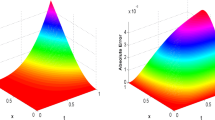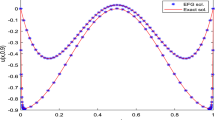Abstract
More recently, it is discovered in the field of applied sciences and engineering that the telegraph equation is better suited to model reaction-diffusion than the ordinary diffusion equation. In this article, the second-order hyperbolic telegraph equations are analyzed numerically by means of an efficient local differential quadrature method utilizing the radial basis functions. The explicit time integration technique is used to semi-discretize the model in the time direction, while the space derivatives are discretized by the proposed meshless procedure. To test the accuracy and capabilities of the method, five test problems are considered utilizing both rectangular and non-rectangular domains, which show that the proposed scheme solutions are converging extremely quick in comparison with the different existing numerical techniques in the recent literature.











Similar content being viewed by others
References
C. Rong-Jun, G. Hong-Xia, Element-free Galerkin (EFG) method for a kind of two-dimensional linear hyperbolic equation. Chin. Phys. B 18(10), 4059 (2009)
I. Komashynska, M. Al-Smadi, A. Ateiwi, S. Al-Obaidy, Approximate analytical solution by residual power series method for system of fredholm integral equations. Appl. Math. Inf. Sci. 10, 1–11 (2016)
H. Ahmad, A.R. Seadawy, T.A. Khan, Study on numerical solution of dispersive water wave phenomena by using a reliable modification of variational iteration algorithm. Math. Comput. Simul. 177, 13–23 (2020)
M.A. Aal, N. Abu-Darwish, O.A. Arqub, M. Al-Smadi, S. Momani, Analytical solutions of fuzzy fractional boundary value problem of order 2\(\alpha \) by using RKHS algorithm. Appl. Math. Inf. Sci. 13(4), 523–533 (2019)
R. Mohanty, M. Jain, An unconditionally stable alternating direction implicit scheme for the two space dimensional linear hyperbolic equation. Numer. Methods Partial Differ. Equ. Int. J. 17(6), 684–688 (2001)
R. Mohanty, New unconditionally stable difference schemes for the solution of multi-dimensional telegraphic equations. Int. J. Comput. Math. 86(12), 2061–2071 (2009)
B. Bülbül, M. Sezer, A Taylor matrix method for the solution of a two-dimensional linear hyperbolic equation. Appl. Math. Lett. 24(10), 1716–1720 (2011)
M. Dehghan, S. Yousefi, A. Lotfi, The use of He’s variational iteration method for solving the telegraph and fractional telegraph equations. Int. J. Numer. Methods Biomed. Eng. 27(2), 219–231 (2011)
R. Jiwari, S. Pandit, R. Mittal, A differential quadrature algorithm to solve the two dimensional linear hyperbolic telegraph equation with Dirichlet and Neumann boundary conditions. Appl. Math. Comput. 218(13), 7279–7294 (2012)
R. Mittal, R. Bhatia, A numerical study of two dimensional hyperbolic telegraph equation by modified B-spline differential quadrature method. Appl. Math. Comput. 244, 976–997 (2014)
R.M. Hafez, Numerical solution of linear and nonlinear hyperbolic telegraph type equations with variable coefficients using shifted jacobi collocation method. Comput. Appl. Math. 37(4), 5253–5273 (2018)
H. Ahmad, Variational iteration method with an auxiliary parameter for solving telegraph equations. J. Nonlinear Anal. Appl. 2(2018), 223–232 (2018)
A.E. Harrak, A. Bergam, Preserving finite-volume schemes for two-time reaction-diffusion model. Appl. Math. Inf. Sci. 14, 41–50 (2020)
H. Ahmad, A.R. Seadawy, T.A. Khan, P. Thounthong, Analytic approximate solutions for some nonlinear parabolic dynamical wave equations. J. Taibah Univ. Sci. 14(1), 346–358 (2020)
M. Dehghan, A. Shokri, A meshless method for numerical solution of a linear hyperbolic equation with variable coefficients in two space dimensions. Numer. Methods Partial Differ. Equ. Int. J. 25(2), 494–506 (2009)
M. Dehghan, A. Ghesmati, Combination of meshless local weak and strong (MLWS) forms to solve the two dimensional hyperbolic telegraph equation. Eng. Anal. Bound. Elem. 34(4), 324–336 (2010)
M. Dehghan, R. Salehi, A method based on meshless approach for the numerical solution of the two-space dimensional hyperbolic telegraph equation. Math. Methods Appl. Sci. 35(10), 1220–1233 (2012)
S. Abbasbandy, H.R. Ghehsareh, I. Hashim, A. Alsaedi, A comparison study of meshfree techniques for solving the two-dimensional linear hyperbolic telegraph equation. Eng. Anal. Bound. Elem. 47, 10–20 (2014)
D. Rostamy, M. Emamjome, S. Abbasbandy, A meshless technique based on the pseudospectral radial basis functions method for solving the two-dimensional hyperbolic telegraph equation. Eur. Phys. J. Plus 132(6), 263 (2017)
J. Lin, F. Chen, Y. Zhang, J. Lu, An accurate meshless collocation technique for solving two-dimensional hyperbolic telegraph equations in arbitrary domains. Eng. Anal. Bound. Elem. 108, 372–384 (2019)
M. Aslefallah, D. Rostamy, Application of the singular boundary method to the two-dimensional telegraph equation on arbitrary domains. J. Eng. Math. 118(1), 1–14 (2019)
Y. Zhou, W. Qu, Y. Gu, H. Gao, A hybrid meshless method for the solution of the second order hyperbolic telegraph equation in two space dimensions. Eng. Anal. Bound. Elem. 115, 21–27 (2020)
S. Reutskiy, Y. Zhang, J. Lin, H. Sun, Novel numerical method based on cubic B-splines for a class of nonlinear generalized telegraph equations in irregular domains. Alex. Eng. J. 59(1), 77–90 (2020)
I. Ahmad, H. Ahmad, P. Thounthong, Y.-M. Chu, C. Cesarano, Solution of multi-term time-fractional PDE models arising in mathematical biology and physics by local meshless method. Symmetry 12(7), 1195 (2020)
M.H. Srivastava, H. Ahmad, I. Ahmad, P. Thounthong, N. M. Khan, Numerical simulation of three-dimensional fractional-order convection-diffusion PDEs by a local meshless method. Therm. Sci. (00), 210–210 (2020)
I. Ahmad, M.N. Khan, M. Inc, H. Ahmad, K. Nisar, Numerical simulation of simulate an anomalous solute transport model via local meshless method. Alex. Eng. J. 59, 2827–2838 (2020)
R.L. Hardy, Multiquadric equations of topography and other irregular surfaces. J. Geophys. Res. 76(8), 1905–1915 (1971)
R. Franke, Scattered data interpolation: tests of some methods. Math. Comput. 38(157), 181–200 (1982)
E.J. Kansa, Multiquadrics—a scattered data approximation scheme with applications to computational fluid-dynamics-I surface approximations and partial derivative estimates. Comput. Math. Appl. 19(8–9), 127–145 (1990)
E.J. Kansa, Multiquadrics—a scattered data approximation scheme with applications to computational fluid-dynamics-II solutions to parabolic, hyperbolic and elliptic partial differential equations. Comput. Math. Appl. 19(8–9), 147–161 (1990)
C. Franke, R. Schaback, Convergence order estimates of meshless collocation methods using radial basis functions. Adv. Comput. Math. 8(4), 381–399 (1998)
W. Madych, S. Nelson, Multivariate interpolation and conditionally positive definite functions, II. Math. Comput. 54(189), 211–230 (1990)
G.E. Fasshauer, Meshfree Approximation Methods with MATLAB, vol. 6 (World Scientific, Singapore, 2007)
H. Wendland, Scattered Data Approximation, vol. 17 (Cambridge University Press, Cambridge, 2004)
G.E. Fasshauer, Newton iteration with multiquadrics for the solution of nonlinear PDEs. Comput. Math. Appl. 43(3–5), 423–438 (2002)
G.E. Fasshauer, J.G. Zhang, On choosing “optimal” shape parameters for RBF approximation. Numer. Algorithms 45(1–4), 345–368 (2007)
R. Cavoretto, A. De Rossi, M. Mukhametzhanov, Y.D. Sergeyev, On the search of the shape parameter in radial basis functions using univariate global optimization methods. J. Glob. Optim. 1–23 (2019)
S. Rippa, An algorithm for selecting a good value for the parameter c in radial basis function interpolation. Adv. Comput. Math. 11(2–3), 193–210 (1999)
M. Uddin, On the selection of a good value of shape parameter in solving time-dependent partial differential equations using RBF approximation method. Appl. Math. Model. 38(1), 135–144 (2014)
R. Cavoretto, A. De Rossi, An adaptive LOOCV-based refinement scheme for RBF collocation methods over irregular domains. Appl. Math. Lett. 103, 106178 (2020)
R. Cavoretto, A. De Rossi, A two-stage adaptive scheme based on RBF collocation for solving elliptic PDEs. Comput. Math. Appl. (2020)
J. Biazar, M. Hosami, An interval for the shape parameter in radial basis function approximation. Appl. Math. Comput. 315, 131–149 (2017)
M. Nawaz, I. Ahmad, H. Ahmad, A radial basis function collocation method for space-dependent inverse heat problems. J. Appl. Comput. Mech. (2020)
I. Ahmad, S. Zaman, Local meshless differential quadrature collocation method for time-fractional PDEs. Discrete Contin. Dyn. Syst. 13(10), 2641–2654 (2020)
I. Ahmad, M. Ahsan, Z. Din, M. Ahmad, P. Kumam, An efficient local formulation for time-dependent PDEs. Mathematics 7, 216 (2019)
M.N. Khan, I. Hussain, I. Ahmad, H. Ahmad, A local meshless method for the numerical solution of space-dependent inverse heat problems. Math. Methods Appl. Sci. (2020)
I. Ahmad, M. Ahsan, I. Hussain, P. Kumam, W. Kumam, Numerical simulation of PDEs by local meshless differential quadrature collocation method. Symmetry 11(3), 394 (2019)
I. Ahmad, A.Q.M. Khaliq, Local RBF method for multi-dimensional partial differential equations. Comput. Math. Appl. 74, 292–324 (2017)
C. Shu, Differential Quadrature and Its Application in Engineering (Springer, London, 2000)
C. Shu, H. Ding, K. Yeo, Local radial basis function-based differential quadrature method and its application to solve two-dimensional incompressible Navier–Stokes equations. Comput. Methods Appl. Mech. Eng. 192, 941–954 (2003)
B.K. Singh, P. Kumar, An algorithm based on a new DQM with modified extended cubic B-splines for numerical study of two dimensional hyperbolic telegraph equation. Alex. Eng. J. 57(1), 175–191 (2018)
R. Siraj-ul-islam, B. Šarler et al., Local radial basis function collocation method along with explicit time stepping for hyperbolic partial differential equations. Appl. Numer. Math. 67, 136–151 (2013)
M. Rahman, M. Akhtar, A. Shaikh, A. Bhunia, Newton’s P-difference interpolation formula for interval-valued function. Appl. Math. Inf. Sci. 14, 155–167 (2020)
M. Rehman, Z. Arif, Numerical approximation of bounds of -values for a family of pascal matrices. Appl. Math. Inf. Sci. 13, 271–277 (2019)
J. Avila, R. Lobato, J. Chuquipoma, M.D. Santos, Exponential stability and numerical results of a coupled system of wave equations with indirect control. Appl. Math. Inf. Sci. 14, 405–414 (2020)
Author information
Authors and Affiliations
Corresponding author
Ethics declarations
Conflict of interest
No conflict of interest.
Electronic supplementary material
Below is the link to the electronic supplementary material.
Rights and permissions
About this article
Cite this article
Ahmad, I., Ahmad, H., Abouelregal, A.E. et al. Numerical study of integer-order hyperbolic telegraph model arising in physical and related sciences. Eur. Phys. J. Plus 135, 759 (2020). https://doi.org/10.1140/epjp/s13360-020-00784-z
Received:
Accepted:
Published:
DOI: https://doi.org/10.1140/epjp/s13360-020-00784-z




